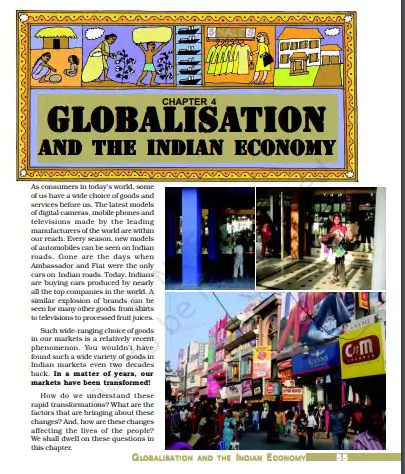‘NCERT Solutions for Class 10 Social Science Chapter 4 Power Sharing‘ PDF Quick download link is given at the bottom of this article. You can see the PDF demo, size of the PDF, page numbers, and direct download Free PDF of ‘Ncert Class 10 Social Science Chapter 4 Exercise Solution’ using the download button.
Globalisation and the Indian Economy Book PDF Free Download

Chapter 4: Globalisation and the Indian Economy
As consumers in today’s world, some of us have a wide choice of goods and services before us. The latest models of digital cameras, mobile phones and televisions made by the leading manufacturers of the world are within our reach. Every season, new models of automobiles can be seen on Indian roads. Gone are the days when Ambassador and Fiat were the only cars on Indian roads.
Today, Indians are buying cars produced by nearly all the top companies in the world. A similar explosion of brands can be seen for many other goods: from shirts to televisions to processed fruit juices. Such wide-ranging choice of goods in our markets is a relatively recent phenomenon. You wouldn’t have found such a wide variety of goods in Indian markets even two decades back.
In a matter of years, our markets have been transformed! How do we understand these rapid transformations? What are the factors that are bringing about these changes? And, how are these changes affecting the lives of the people? We shall dwell on these questions in this chapter.
Until the middle of the twentieth century, production was largely organised within countries. What crossed the boundaries of these countries were raw materials, food stuff and finished products. Colonies such as India exported raw materials and food stuff and imported finished goods. Trade was the main channel connecting distant countries.
This was before large companies called Spreading of Production by an MNC A large MNC, producing industrial equipment, designs its products in research centres in the United States, and then has the components manufactured in China. These are then shipped to Mexico and Eastern Europe where the products are assembled and the finished products are sold all over the world.
Meanwhile, the company’s customer care is carried out through call centres located in India. PRODUCTION ACROSS COUNTRIES multinational corporations (MNCs) emerged on the scene. A MNC is a company that owns or controls production in more than one nation. MNCs set up offices and factories for production in regions where they can get cheap labour and other resources.
This is done so that the cost of production is low and the MNCs can earn greater profits. Consider the following example. In this example the MNC is not only selling its finished products globally, but more important, the goods and services are produced globally. As a result, production is organised in increasingly complex ways.
The production process is divided into small parts and spread out across the globe. In the above example, China provides the advantage of being a cheap manufacturing location. Mexico and Eastern Europe are useful for their closeness to the markets in the US and Europe. India has highly skilled engineers who can understand the technical aspects of production.
It also has educated English speaking youth who can provide customer care services. And all this probably can mean 50-60 per cent cost-savings for the MNC! The advantage of spreading out production across the borders to the multinationals can be truly immense.
| Author | NCERT |
| Language | English |
| No. of Pages | 20 |
| PDF Size | 0.6 MB |
| Category | Social Science |
| Source/Credits | ncert.nic.in |
NCERT Solutions Class 11 Social Science Chapter 4 Globalisation and the Indian Economy
Question 1: What do you understand by globalisation? Explain in your own words.
Answer:
- Globalization is a process of interaction and integration among the people, companies, and governments of different nations, a process driven by international trade and investment and aided by information technology.
- Under globalization the countries that hitherto closed to trade and foreign investment open up their economies and go global. The result is increasing interconnectedness and integration of the economies of the world.
- Under globalization more and more goods and services, investments and technology are moving between countries.
- In addition to goods, services, investments, and technology, there is a movement of people who move from one country to another in search of better income, better jobs or better education.
Question 2: What was the reason for putting barriers to foreign trade and foreign investment by the Indian government? Why did it wish to remove these barriers?
Answer:
(1) The government had put restrictions on the import of goods to protect domestic producers from foreign competition because industries were coming up in the 1950s and 1960s, and competition from imports at that stage would not have allowed these industries to come up. Thus, the government allowed imports of only essential items such as machinery, fertilizers, and petroleum. These restrictions helped to attain technological capability within the country.
(2) Starting around 1991, the government wished to remove the barriers due to reasons as mentioned below :
- India had attained technological capability.
- The government decided that the time had come for Indian producers to compete with producers around the globe.
- It felt that competition would improve the performance of producers within the country since they would have to improve their quality.
- There would be an unrestricted exchange of capital, technology, and experience between India and other countries of the world.
Thus, barriers to foreign trade and foreign investment were removed. Now goods could be imported and exported easily. The government reduced taxes on imported goods, and encouraged investors from abroad to invest in India.
NCERT Class 11 Social Science Textbook Chapter 4 With Answer PDF Free Download
